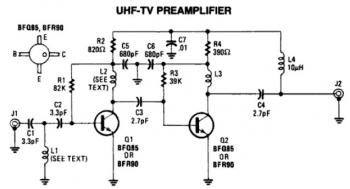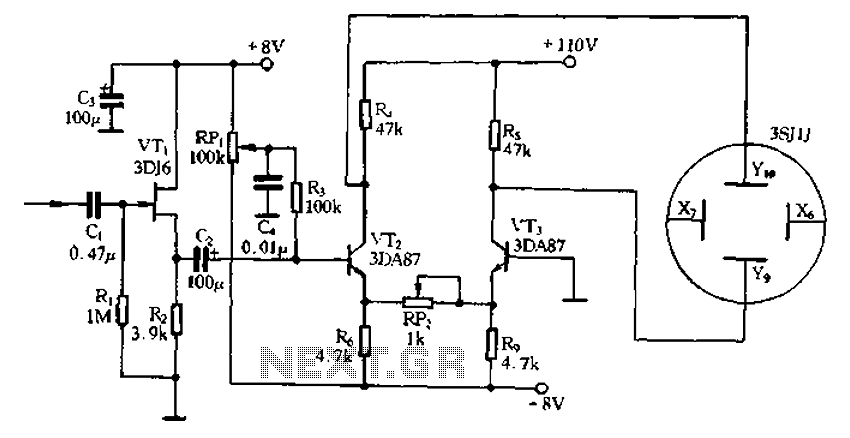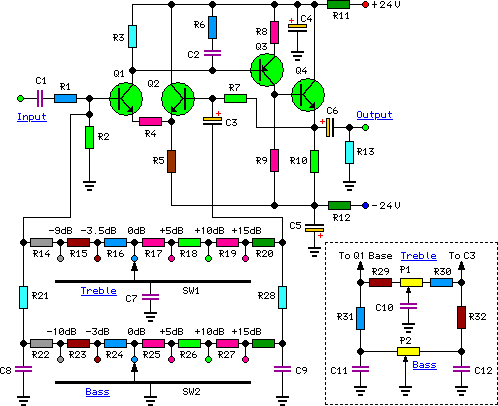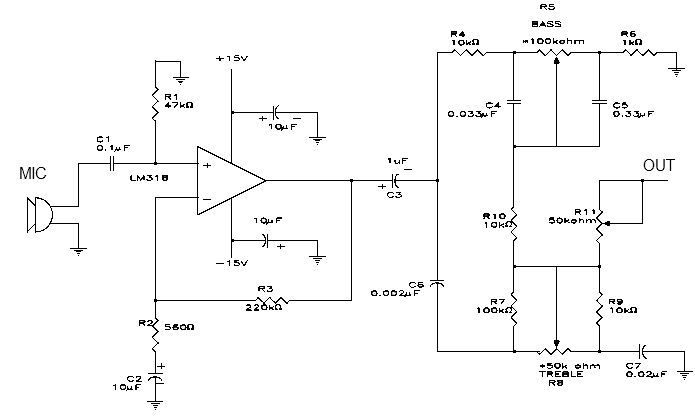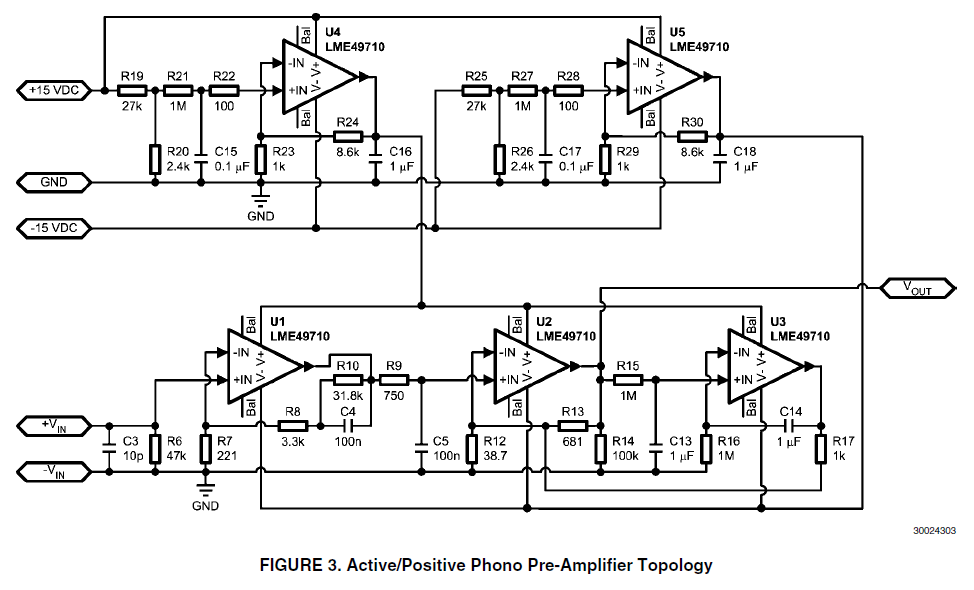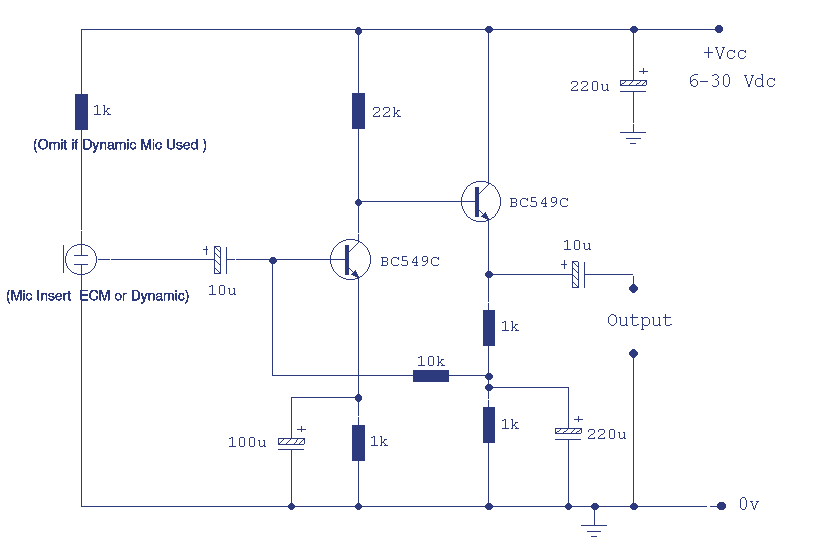
Oscilloscope Preamp
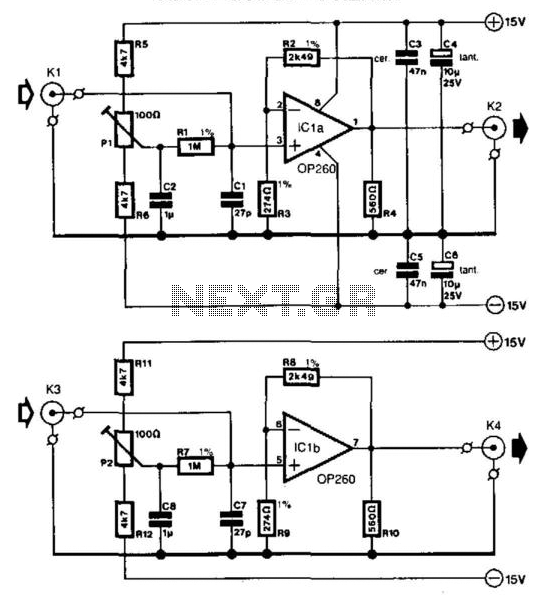
In many oscilloscopes, the most sensitive range is between 2 to 5 mV, although it is often possible to improve this to 1 to 2 mV by using a variable gain control. To achieve even better sensitivity, the current preamplifier, which has an amplification factor of about 10 (20 dB), may be beneficial. Since most oscilloscopes possess a bandwidth of 20 MHz or greater, the amplifier must have a slightly wider bandwidth, which can be accomplished with the OP260 operational amplifier. This op-amp has a slew rate of 550 V/μs (at an amplification of 10) and a bandwidth of 40 MHz that remains largely independent of the amplification. However, the gain versus frequency response is not optimal, as illustrated in the provided figure, where the characteristics are shown for various load conditions. The peak in the curves depends on the feedback resistor value, which appears to be optimal at 2.5 kΩ. The curves also illustrate different values of R2/R1 for an amplification factor of 10. Experimentation with the R2/R1 ratio for various amplification factors can yield insightful results. It is important to note that the output impedance increases from 20 to 225 Ω over the frequency range of 10 MHz to 60-70 MHz. Therefore, it is crucial to keep all connections on the prototyping board as short as possible and to connect all ground points to a common ground using a dedicated, heavy track. Additionally, the use of an IC socket is discouraged. An input impedance of 1 kΩ was selected, resulting in a relatively high noise level at the output when the input is open-circuited. This impedance can be reduced to prevent issues with a 1:10 probe, which would otherwise experience persistent noise problems. However, when the amplifier is connected to an appropriate source, the noise reduction is typically sufficient to produce a clear trace on the screen. Presets PI and P2 allow for compensation of the DC offset and input offset caused by resistors R1 and R7, respectively. The input bias current for the non-inverting input is approximately ten times lower than that for the inverting input, making the OP260 more suitable for non-inverting configurations. The inverting configuration may encounter issues due to the low values of R2 (R1) and R3 (R9). The input bias current is generally around 0.2 μA, with an input offset of about 3 mV (maximum 7 mV). In this circuit type, utilizing a well-regulated power supply is critical. The power supply suppression up to 10 kHz is approximately 70 dB, decreasing with increasing frequency. Any noise or small ripple on the supply lines could render the circuit ineffective as a small-signal amplifier. The circuit consumes about 14 mA of current. The slew rate, like that of most operational amplifiers, is asymmetric and may cause visible signal distortion when driving a 560 Ω resistor at higher frequencies.
The described circuit employs the OP260 operational amplifier to enhance the sensitivity of an oscilloscope. The choice of a variable gain control allows for fine-tuning the sensitivity range, making it adaptable to various signal levels. The amplifier's design incorporates feedback resistors that significantly influence the gain and frequency response, necessitating careful selection to optimize performance. The importance of maintaining short connections and a common ground is emphasized to minimize noise and ensure stability, which is critical in high-frequency applications.
The circuit's input impedance is set to balance sensitivity and noise performance, with the potential for adjustment to accommodate different probing techniques. The use of presets for DC offset compensation indicates a thoughtful design approach to ensure accurate signal representation. The characteristics of the OP260, including its slew rate and bias currents, inform the design choices and operational parameters, ensuring that the circuit can handle a variety of signal conditions without introducing significant distortion or noise.
Overall, this circuit exemplifies the principles of operational amplifier design in sensitive measurement applications, demonstrating how component selection and circuit layout can significantly impact performance in precision electronics. In many oscilloscopes, the most sensitive range is 2 to 5 mV, although it is often possible to improve this to 1 to 2 m V by a variable gain control. To obtain even better sensitivity, the present preamplifier, which has an amplification of about 10 (20 dB), might be useful. Because most oscilloscopes have a bandwidth of 20 MHz or more, the amplifier must, of course, have a slightly wider bandwidth and that is achieved with a Type OP260 op amp.
This has a slew rate of 550 V7 (is (at an amplification of 10) and a bandwidth of 40 MHz that is virtually independent of the amplification. The gain vs. frequency response is not so good, however: as can be seen from Fig. 39-1 (b), where the characteristics are given for a number of loads. The hump in the curves depends on the value of the feedback resistor, whose optimum value appears to be 2.5 KOhmhm.
The curves in Fig. 39-l(c) accord with different values of R2/R$ for an amplification factor of 10. Some experimentation with the value of R2/Rs for different amplification factors can be instructive. Remember, however, that the output impedance increases from 20 to 225 over the frequency range of 10 MHz to 60 - 70 MHz. It is therefore important to keep all connections on the prototyping board as short as possible and to connect all earth points to a common ground via a separate, heavy track.
Also, do not use an IC socket. An input impedance of 1 was chosen, which results in a fairly high level of noise at the output (with open-circuit input). This value can be reduced, because otherwise the use of a 1:10 probe will be inhibited; it would give constant problems with the noise.
However, when the amplifier is connected to .a suitable source, the noise reduction is normally more than ample to obtain a good trace on the screen. Presets PI and P2 provide compensation for the dc offset and input offset, caused by Rl and R7 respectively.
The input bias current for the noninverting input is about 10 times lower than that for the inverting input, which makes the OP260 more suitable for noninverting circuits. The inverting circuit can also give problems because of the low values of R2 {R%) and R3 (i9). The input bias current is typically 0.2, and the input offset is about 3 mV (max. 7 mV). In this type of circuit, it is important to use a well-regulated power supply. The power-supply suppression up to 10 kHz is roughly 70 dB, and this reduces with increasing frequency.
Any noise or tiny ripple on the supply lines would make the application of the circuit as a small-signal amplifier impossible. The circuit draws a current of about 14 mA. The slew rate, as with most op amps, is asymmetric and might lead to visible distortion of the signal when the drive to the 560- resistor is high at the higher frequencies.
🔗 External reference
The described circuit employs the OP260 operational amplifier to enhance the sensitivity of an oscilloscope. The choice of a variable gain control allows for fine-tuning the sensitivity range, making it adaptable to various signal levels. The amplifier's design incorporates feedback resistors that significantly influence the gain and frequency response, necessitating careful selection to optimize performance. The importance of maintaining short connections and a common ground is emphasized to minimize noise and ensure stability, which is critical in high-frequency applications.
The circuit's input impedance is set to balance sensitivity and noise performance, with the potential for adjustment to accommodate different probing techniques. The use of presets for DC offset compensation indicates a thoughtful design approach to ensure accurate signal representation. The characteristics of the OP260, including its slew rate and bias currents, inform the design choices and operational parameters, ensuring that the circuit can handle a variety of signal conditions without introducing significant distortion or noise.
Overall, this circuit exemplifies the principles of operational amplifier design in sensitive measurement applications, demonstrating how component selection and circuit layout can significantly impact performance in precision electronics. In many oscilloscopes, the most sensitive range is 2 to 5 mV, although it is often possible to improve this to 1 to 2 m V by a variable gain control. To obtain even better sensitivity, the present preamplifier, which has an amplification of about 10 (20 dB), might be useful. Because most oscilloscopes have a bandwidth of 20 MHz or more, the amplifier must, of course, have a slightly wider bandwidth and that is achieved with a Type OP260 op amp.
This has a slew rate of 550 V7 (is (at an amplification of 10) and a bandwidth of 40 MHz that is virtually independent of the amplification. The gain vs. frequency response is not so good, however: as can be seen from Fig. 39-1 (b), where the characteristics are given for a number of loads. The hump in the curves depends on the value of the feedback resistor, whose optimum value appears to be 2.5 KOhmhm.
The curves in Fig. 39-l(c) accord with different values of R2/R$ for an amplification factor of 10. Some experimentation with the value of R2/Rs for different amplification factors can be instructive. Remember, however, that the output impedance increases from 20 to 225 over the frequency range of 10 MHz to 60 - 70 MHz. It is therefore important to keep all connections on the prototyping board as short as possible and to connect all earth points to a common ground via a separate, heavy track.
Also, do not use an IC socket. An input impedance of 1 was chosen, which results in a fairly high level of noise at the output (with open-circuit input). This value can be reduced, because otherwise the use of a 1:10 probe will be inhibited; it would give constant problems with the noise.
However, when the amplifier is connected to .a suitable source, the noise reduction is normally more than ample to obtain a good trace on the screen. Presets PI and P2 provide compensation for the dc offset and input offset, caused by Rl and R7 respectively.
The input bias current for the noninverting input is about 10 times lower than that for the inverting input, which makes the OP260 more suitable for noninverting circuits. The inverting circuit can also give problems because of the low values of R2 {R%) and R3 (i9). The input bias current is typically 0.2, and the input offset is about 3 mV (max. 7 mV). In this type of circuit, it is important to use a well-regulated power supply. The power-supply suppression up to 10 kHz is roughly 70 dB, and this reduces with increasing frequency.
Any noise or tiny ripple on the supply lines would make the application of the circuit as a small-signal amplifier impossible. The circuit draws a current of about 14 mA. The slew rate, as with most op amps, is asymmetric and might lead to visible distortion of the signal when the drive to the 560- resistor is high at the higher frequencies.
🔗 External reference
